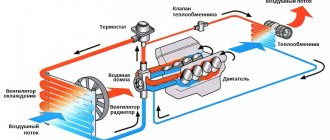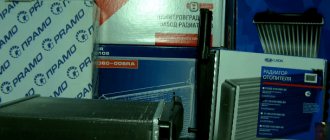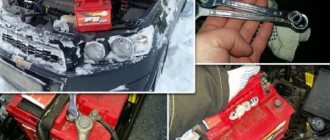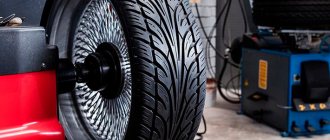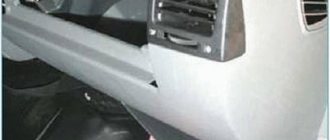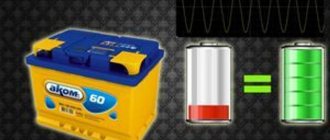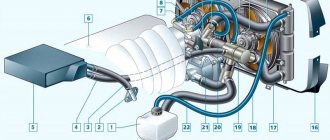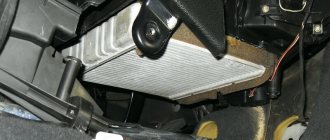Car radiator. Does it need to be washed?
Dust, sand, winter salt, insects and other debris clog the radiator honeycombs. Few people think about it, but dirty radiators can lead to car breakdowns, the repair of which will cost owners a significant amount of money. This problem is aggravated depending on the complexity and modernity of the car itself. Today, most cars have multiple radiators in their design, including radiators for automatic transmission cooling systems, located in hard-to-reach places.
All of the above contaminants, clogging the radiator honeycombs, create a very dense layer. This layer begins to work as a kind of insulation, preventing the radiators from performing their immediate functions - COOLING THE LIQUID CIRCULATING IN THEM!
This leads to an increase in the operating temperature of the engine and other units. The motor overheats and may fail. How to save yourself from possible expensive repairs? Let's look at this problem in more detail.
The main symptoms of an emerging problem.
Before using an expensive sink, you need to make sure it is necessary. The cooling fan is often humming under the hood, but there is no reason for this, so it’s time to take a look at the cooling radiator with a flashlight. Contamination is visible to the naked eye. Blades of grass, dirt, insects and all kinds of road debris get clogged between the honeycombs. Most often it looks like a gray incomprehensible mass that is impenetrable to air flow.
In the summer, the cooling cells become clogged with poplar fluff, grass and sticky buds. Under the influence of high temperature, they are sintered into a monolith with dirt and road dust. Air flows cannot break through such a cushion, and the engine cooling process is disrupted. But the worst thing happens when winter dirt mixed with salt and other reagents is applied to the old poplar fluff.
It usually takes several years before a brand new radiator experiences a heat transfer deficiency. Cars that drive for long periods of time on intercity highways are at risk. The speed is high, the energy of impact with dust particles is high, the dirt digs deep into the honeycombs.
Big problems await those cars that stay behind dusty trucks for hours. Not only do stones fly from under the wheels into the windows, but the rising clouds of dust clog not only the radiator, but also all the filters. In winter, trucks emit an emulsion of water, sand and dissolved chemicals. This substance adheres to the radiator and literally cements the space between the cells. Under the influence of temperature, the slurry cokes into a hard crust. And here you should not be deceived: it will never fall off on its own; careful cleaning is required.
When does the cooling radiator need to be flushed?
Clear signs that the cooling system needs cleaning:
- the cooling fan turns on more often, and not only at idle, but also while driving;
- the engine heats up quickly;
- Antifreeze is thrown out of the expansion tank when heated;
- the bottom of the radiator and the lower pipe are cold, the upper hoses of the cooling system are hot;
- the heater in the car does not heat well;
Over time, scale accumulates in the cooling system. When draining the coolant from the radiator, pay attention to the content of sediments, particles and color changes in it.
A cloudy liquid containing particles of an unknown substance indicates that there is probably scale on the walls of the system. Although not always, even clean liquid indicates the good condition of the radiator from the inside.
A sealant can also get into the coolant, which can be used to seal small cracks and holes. Oil may also get in here.
Types of cooling system cleaning
Cleaning the car cooling system is divided into internal and external work.
Interior work
. Internal cleaning involves eliminating traces of corrosion, engine oil residues, coolant (antifreeze or antifreeze), as well as accumulated scale.
Exterior works
. Consists of external cleaning of all components of the cooling system. That is, we wash off dust, dirt, sand, etc. from it. It is also necessary to thoroughly wash off any insects adhering to it from the radiator honeycomb.
When is cleaning needed?
While the car is moving, the radiator grill takes on all the dust and dirt that comes along the way and clogs the honeycombs. You can find several different radiators in a car: the main one for cooling the engine, for the automatic transmission, and the air conditioner. Sometimes radiators are installed for power steering.
The main radiator is located closer to the engine, so it has less air flow. The remaining heat exchangers only partially reduce their efficiency during operation. And cooling the engine can cause a lot of trouble for the car owner and even lead to a major overhaul of the power unit.
Heat exchangers become clogged both externally and internally. In their cavities, deposits, corrosion and oxidation products of parts made of aluminum alloys accumulate. It is recommended to combine washing of such components with foam and other means with replacing the antifreeze. The timing of this procedure differs for different cars. But, according to the experience of owning a car, after a mileage of 90 thousand km, it is necessary to update the coolant.
Engine efficiency depends on the time of year and ambient temperature. Routine washing and cleaning of the engine radiator is usually carried out in the spring. Before the hot season, it is necessary to remove all foreign particles and dirt from inside the cooling system, since in summer the thermal conditions of the engine are especially important.
Before you start cleaning the radiator, you need to make sure that it is time to do this work. To do this, you need to carry out a simple check that any driver can perform.
Signs of a clogged radiator
If you carefully monitor the operation of the engine and car systems, it is easy to spot signs that it is time to clean the radiator.
- The cooling fan began to operate frequently both at idle and while driving.
- The engine quickly gains temperature, and the antifreeze boils and is thrown out of the expansion tank.
- The upper radiator pipes and hoses are hot, but the lower ones remain cold for a long time.
- The interior heater or air conditioner is not operating efficiently.
- The overheating warning light on the instrument panel lights up.
But the listed signs may indicate other malfunctions:
- there is an air lock in the cooling system;
- the ignition setting has gone wrong;
- The thermostat is faulty;
- The cylinder head gasket is burnt or punctured.
Given the difficulty in diagnosing and identifying the causes of malfunctions, it is necessary to approach this issue more carefully.
Even if you have not found the cause of the engine overheating, cleaning the radiator will not hurt. Moreover, when there are all the signs of its contamination:
- The antifreeze in the expansion tank has darkened, corrosion particles have appeared, and the color has become cloudy.
- On the outside of the radiator there is dirt, debris, and honeycombs are clogged with insects.
If no signs are detected, but there are malfunctions in the cooling system, it is recommended to contact a car service center.
How and with what to flush the inside of the radiator?
To flush the radiator from the inside, you can use one of the following products:
- Citric acid;
- Pepsi or Cola;
- Electrolyte;
- Distilled water;
- Finished drugs;
Let's talk about each of these methods in more detail.
Flushing the cooling radiator with citric acid
1)
. As in general and with almost any manipulations with the cooling system, you need to wait until the power unit cools down completely, otherwise you can get unpleasant and, in some cases, dangerous burns from steam escaping through the radiator cap.
2)
. We prepare the solution as follows: dilute 100 grams of citric acid with the volume of water that is enough to fill the engine cooling system.
3)
. Next, we need to drain the used liquid and fill in the prepared composition instead. We've been driving the car for about a week. During this time, when interacting with acid, all contaminants inside the cooling system and heat exchanger are dissolved.
4)
. After a week, the liquid with acid must be drained, and the entire system must be rinsed from the inside with distilled water, after which we fill the cooling system with antifreeze or antifreeze.
Flushing the cooling radiator with cola (or pepsi)
1)
. We drain all the liquid from the cooling system and pour in Coca-Cola, previously heated, so that carbon dioxide does not escape from it.
2)
. If the nature of the deposits is not critical, it will be sufficient if the engine runs for 5-10 minutes. But in cases where pollution greatly burdens the system, then it is necessary to ride during the day.
3)
. Then drain the Cola, rinse it with distilled water, and then fill it with fresh coolant.
Flushing the cooling radiator with electrolyte
To flush the radiator, you can also use battery electrolyte with a density of 1.27.
1)
. In a large 10-liter bucket, mix clean water with a liter of this substance, then pour the resulting solution into the cooling system.
2)
. All trips on this day must be made with a filled radiator, which will allow it to be cleaned as much as possible.
3)
. In the evening, drain the solution and rinse the radiator with clean water, then add coolant.
Attention! I have not personally used this method, but according to reviews on the Internet, electrolyte is also an effective means for cleaning a radiator.
Flushing the radiator with distilled water
If, when replacing the coolant, you do not notice any special contamination, then it is quite possible to get by with distilled water. It is not recommended to use tap water with a large amount of salts and impurities. As an example, you can take a kettle, on which scale appears after using tap water.
1)
. Pour clean water into the radiator and start the car at idle speed.
2)
. 20 minutes after operating in this mode, drain the water and add coolant.
Ready-made drugs
Today you can find many options for special flushing fluids on sale. They can be either alkaline or acidic. They are best used according to the instructions.
Video
How to flush the inside of a car radiator
Before starting work, you must drain the coolant. To do this, you need to prepare a container and buy new coolant. Many cars have special taps installed for draining. In order for the antifreeze to completely leave the system, you need to disconnect all pipes and hoses.
Attention! Before draining, it is recommended to warm the motor to operating temperature so that the liquid circulates in the system. You can drain it after the engine has cooled down.
After this, you need to reassemble everything in the reverse order and pour the existing cleaning agent into the cooling system. You need to let the engine run for the time specified in the instructions, and then drain the chemicals. Then you need to fill in fresh antifreeze, start the engine and let it run. This is necessary to remove air pockets from the system.
During flushing work, it is necessary to use protective equipment, such as rubber gloves. The cleaning procedure is not difficult, but plays an important role in the operation of the power unit. This work must be done in a timely manner and combined with replacing antifreeze, so as not to spend extra money on its purchase.
How and with what to flush the radiator from the outside?
Dust and debris can cause contamination on the outside of the radiator. This part gets dirty much faster if the vehicle is driven on country roads or in areas where there is serious dust.
Pollution can also be caused by insects that get here during the operation of the vehicle. Later they turn into a fairly solid mass.
To flush the radiator from the outside without removing it, you can use ordinary water using a high-pressure washer. This cleaning method is very effective, but there are negative reviews that say that the high-pressure washer bends the radiator honeycombs. In fact, you just need to learn how to use the sink correctly.
For example, to safely wash a radiator, it is enough to use a “vario” as a nozzle, and not a “mill”. You can use the maximum speed, but wash not point-blank, but at a distance of 30-50cm from the radiator. In addition, the angle must be right or close to it.
I would also like to note that getting to some areas of the radiator is not so easy, and therefore, if the contamination is quite severe, it is still recommended to remove it.
It also happens that the dirt on the radiator is so firmly embedded that it is very difficult to rinse it thoroughly with ordinary water. In this case, you will have to use a special cleaner to clean the outside of the radiator.
Today, chemical products from the following manufacturers are very popular among many car enthusiasts:
- Hado;
- VERYLUBE;
- Liqui Moly;
Video
1)
. It is recommended to flush the cooling radiator at least once every 2 years. And this is even if the cooling system is working normally.
2)
. If internal and external cleaning does not help solve the problem, then it is still better to purchase a new radiator, since it will cost you much less than engine repair.
Conclusion
As you can see, there is nothing complicated about flushing the radiator. Anyone can handle this. But thanks to periodic flushing, you can not only extend its service life, but also ensure normal engine operation.
It is difficult to determine which component of a car’s cooling system is the main one, but hardly anyone would argue that the radiator occupies one of the key places in this list. Being in the front of the car and cooled by the oncoming air flow, it simultaneously collects from the outside all the dust and contaminants encountered during movement.
The internal design also contributes to the accumulation of rust, scale and other components in the system. Accordingly, first of all, if certain problems arise with engine overheating, you need to clean and flush the car radiator, taking into account the factors described above.
To effectively clean the heat exchanger with your own hands, you should understand: its structure and principle of operation, possible malfunctions, how and by what means and methods it is better to clean the contaminants that have arisen inside and out.
The principle of the engine cooling system is simple: passing through the jacket of the cylinder block, the coolant picks up excess heat and, under pressure created by the pump, enters the radiator, which operates on the principle of a heat exchanger. Here, passing through the core from the upper tank to the lower one, thanks to the air blowing, the antifreeze cools down.
The core of radiators is made of copper or aluminum, depending on their size, and can be in the form of a honeycomb, plate or tubular. Between these channels through which the liquid passes, transverse strips, mainly made of brass, are fixed. They greatly increase the surface area intended for cooling antifreeze, and also help to impart greater rigidity to the entire structure.
To better cool the engine under certain conditions, for example, when driving slowly, when the air flow to the heat exchanger is not so intense, there is a fan behind it that turns on at these moments.
Radiator contamination problem
Over time, adhering dirt clogs the external channels, and the normal operation of the cooling cells is disrupted. Most motorists in this case turn to a car service center, and many, underestimating the complexity of the work, drive the car to the first roadside service station they come across. There, however, they do not stand on ceremony with the radiator, and often use a regular sink to wash the outer part. And we know that the jet of such a washing machine has a pressure of up to 140 atm, and this is enough not only to crush the delicate structure of the cells, but also to tear the honeycombs to shreds. The result of such a tough procedure is a complete replacement of the radiator.
How not to flush a radiator
Radiator malfunctions
The most common heat exchanger malfunctions are:
- Clogging with rust, scale and other debris inside the core.
- Contamination of the outside of the heat exchanger honeycomb with fluff, etc.
- Clogging of the duct from the inside in the radiator pipes with debris.
The following factors will indicate the occurrence of such malfunctions:
- Frequent activation and operation of the fan at high speeds, even when driving at high speed.
- Constant twitching of the temperature sensor needle or its indication that the temperature of the cooling system is too high.
- During the cold period, the heating of the car interior is poor.
You should not ignore these factors, which can lead to engine overheating, which will be signaled not only by the sensor, but also by the expansion tank cap torn off by steam, but clean the heat exchanger from the inside or outside, depending on the type of contamination.
What is it for?
The cooling system is one of the most important elements of a car. Without it, long-term operation of the DVZ is simply impossible. Experts say that the radiator requires attention just as much as anything else. It needs timely diagnosis, cleaning and rinsing. If you ignore these requirements, the system will fail and create a risk of engine overheating.
To properly clean the cooling radiator, you will need:
- antifreeze - from 5 to 8 liters;
- distilled water;
- radiator cleaner;
- soapy water;
- rags and a soft brush.
Using keys and screwdrivers, remove the radiator from the car and wash it in a soapy solution. Next, wash the radiator walls from the inside with a special cleaning agent using a soft brush, and then rinse with distilled water and dry.
Flushing the radiator without disassembling
To clean the heat exchanger with your own hands, inside without removing it, liquids of various compositions are used, both commercially produced and using improvised means.
To clean a car radiator with your own hands, stores sell products produced specifically for this purpose: 3ton Super, STEP UP, Radiator Flush and others.
You can clean the heat exchanger and the entire cooling system at home with simple citric acid and Coca-Cola.
Before you start washing it yourself, you should always wait until the engine has cooled down, otherwise there is a risk of getting burned by the steam when opening the radiator cap or expansion tank.
To clean the inside of the radiator with citric acid you need:
- Make a solution based on the proportions of 100 grams of citric acid to the amount of liquid (distilled water) required to fill the engine cooling system.
- Draining, used liquid and filling, the prepared mixture needs to be driven in a car for about a week. During this time, interacting with citric acid, all contaminants inside the heat exchanger and cooling system will dissolve.
- At the end of the cleaning, drain this liquid and flush the entire system from the inside with distilled water, and add new antifreeze.
Another handy solution for flushing the radiator is Coca-Cola. Cleaning various deposits inside the radiator with Coca-Cola occurs due to the orthophosphoric acid contained in its composition. This is done like this:
- After draining the used coolant, you need to fill the entire volume of the system with Coca-Cola, previously heated, so that carbon dioxide comes out.
- If the pollution is small, then running the engine for 5–10 minutes is enough, but when the heat exchanger has not been washed for a long time, then to effectively clean it, it’s worth driving with Coca-Cola for one day.
- Next, as in all such cases, drain the cleaning liquid, rinse the entire cooling system with distilled water and add fresh antifreeze.
Car radiator design
The heat exchanger of the car cooling system passes antifreeze through itself, with the help of which excess thermal energy is removed from the engine. The liquid must be cooled due to the high thermal conductivity of the radiator’s structural material (copper or aluminum alloy) and constant air flow, for which purpose this unit is placed directly to the car’s bumper.
Engine radiator location
On the other side:
- all dust and dirt from the road gets onto the heat exchanger grilles; cleaning is necessary; the radiator can be mechanically damaged by a random stone;
- when honeycombs become clogged with dirt, the thermal conductivity of the structural material decreases;
- the inside of the tubes becomes clogged with scale and materials contained in the antifreeze, it is necessary to clean the radiator with a special liquid.
External contamination of the heat exchanger
Radiator honeycombs clogged from inside
In modern cars, in addition to the internal combustion engine, coolants circulate in the radiators of the heater and air conditioner. Therefore, for each of these components it is necessary to flush the car radiator with your own hands, and in different ways. The easiest way is to wash the exterior with a high pressure washer.
External radiator cleaning
While driving, a lot of dirt sticks to the outside of the radiator surface: fluff, insect bodies, etc. Getting stuck between the honeycombs, they significantly impair air flow to the heat exchanger.
There are several methods for cleaning the heat exchanger from the outside without dismantling - with water or steam under pressure, but this method is not so effective due to the difficulty of accessing the surface of the radiator. Therefore, experts advise cleaning the heat exchanger with your own hands, after first removing it from the machine.
The removed radiator is cleaned of dirt with your own hands using a regular brush, as well as water and steam.
Properly wash off dirt from the radiator with water using low pressure, on both sides, so as not to damage the soft surface of the heat exchanger.
For better steam cleaning, you will need a steam generator. By treating the radiator grill with steam and gently blowing it without deforming or causing scratches, you can more effectively clean it of dirt stuck inside the honeycomb.
If it is not possible to clean the outside of the radiator with water pressure or steam, then we do this procedure with a regular brush or brush. Having lowered the removed heat exchanger into a suitable container and pre-treated the dirt with foam, carefully wash out with a brush all the dirt that has clogged between the plates.
The fundamental design of cars has not changed for more than a hundred years. Therefore, a car with an internal combustion engine still requires an efficient cooling system. Moreover, every year it should become more and more efficient and reliable; the higher the technological complexity of the power unit, the more critical it is to comply with the temperature regime of its operation.
At the same time, no cooling system can do without a radiator, in which the liquid of the entire system is cooled. The radiator of the cooling system is a key element that ensures stable operation of the car. Therefore, maintaining the cleanliness of this unit means maintaining the stability of the entire vehicle.
Moreover, the radiator can become dirty both outside and inside. With internal contamination, the throughput of the radiator is reduced, and the coolant does not have time to cool to the required temperature. Because of this, the car engine may overheat or operate at a slightly elevated temperature, which contributes to rapid wear of the elements.
The need for cleaning arises due to the design of the radiator itself. It consists of many plates of metal material (usually aluminum or its alloys) located very close to each other. The plates themselves contain small channels through which the heated liquid moves. At the same time, cooling due to the large heat exchange area of the entire radiator structure, cooled by oncoming air.
Therefore, the efficiency of the radiator is very important to maintain a constant temperature regime of the power plant. But, the radiator is open to the oncoming flow of not only air, but also dirt, midges and pebbles. Thus, clogging the fine-mesh structure and preventing the effective exchange of heat with the atmosphere.
You should carefully prevent such contamination and periodically clean an important element of the cooling system. Don’t be afraid of this procedure; even a novice car owner can easily handle the job.
How to flush a radiator
Before flushing the radiator, you should make sure that you need to use special products for cleaning a car radiator.
To determine the degree of contamination, during the process of replacing the coolant (after draining the used material), it is worth pouring clean distilled water into the cooling system. After this, start the car and leave it running for 15-20 minutes. After this, drain the filled water again; if you find that the water has become too dirty and has excess impurities, then you should continue flushing using special cleaning fluids for flushing the radiator. Otherwise, you can add new coolant to the engine cooling system. After draining the test batch of water, it is worth filling the system again, but with the addition of cleaning additives. And repeat the flushing cycle with the engine running for at least 20 minutes. And then you should repeat the procedure again with clean water without additives. This is done to wash out possible residues of cleaning agents, which act aggressively on rubber products and can cause metal corrosion. The system is also rinsed for 20 minutes.
After all the cycles of thoroughly flushing the radiator of your car, you can fill in a fresh batch of coolant. But it is worth remembering that when filling the system, an “air” plug may form. Which will not allow fluid to circulate normally in the system. To remove excess air, you must leave the car engine running and open the radiator cap. At the same time, it is necessary to monitor the antifreeze level and periodically add it to the system.
How to clean a radiator from dirt and dust
If severe contamination of the radiator surface is detected when replacing the coolant.
It is worth the effort to clean the outer surface; it is best to do this on a dismantled unit. The radiator cleaning itself is carried out using running water from a regular hose or a specialized mini car wash. Separately, it is worth noting that the use of mini washers with a high-pressure outlet stream of water can lead to damage to the radiator if handled carelessly. The fact is that the radiator honeycombs are made of a thin sheet of metal that is easy to bend.
At this stage, it is important to remove the bulk of the contamination from large fractions that interfere with the normal circulation of air flow. There is no need to bring the radiator to factory cleanliness.
But it is worth paying attention to possible pockets of corrosion, which should be eliminated using special products that do not contain aggressive acids and solvents. Potent substances can damage the rubber and plastic elements of the radiator.
As a result, you will get a clean radiator that works with the efficiency of a new one. This procedure is recommended to be carried out at least once every two years.
Flushing technology
The general principles for cleaning the heat exchanger of a machine for the user are:
- Ideally, it is better to visit a service station that has a special stand for flushing radiators with temperature and coolant circulation pressure control;
- the heat exchanger needs to be cleaned inside and out; it is best to dismantle it before doing this;
- however, the old antifreeze will have to be replaced with new coolant;
- therefore, the service will cost half the cost of a new radiator, if not more.
Washing stand for internal combustion engine heat exchangers
For example, spare parts for a VAZ are quite cheap; it’s easier to replace the entire heat exchanger or wash it in the garage. To reduce repair time, it is better to service all radiators located under the hood (internal combustion engine, air conditioner and heater) at once.
From the inside
Cleaning the cooling system without dismantling the heat exchanger is carried out using the following technology:
- draining antifreeze through the bottom plug;
- rinsing with boiled or distilled water;
- pouring detergent;
- rinsing with water;
- adding antifreeze and removing air.
Adding detergent
However, when using folk remedies, the liquid remains in the car’s cooling system for several days. Only after this is it drained to flush and fill the heat exchanger with antifreeze. When using some drugs, it is enough to start the engine for a few minutes/hours.
Flushing fluid circulation diagram
It is much more effective to clean the cooling system with the heat exchanger removed. In this case, the radiator can be “shaken” and tilted at different angles to drain out as much of the separated sediment as possible.
Outside
When treating the radiator from the outside, you should use a different technology:
- ensuring access - if you wash a car radiator with your own hands locally, without dismantling it, you should partially disassemble the bumper, grille or remove them entirely;
- applying foam - spray is sprayed from a can onto the heat exchanger honeycombs according to the manufacturer’s instructions;
- flushing - foam is removed along with dissolved dirt from the radiator with steam; the nozzle must be adjusted to a slot jet.
External jet cleaning
Attention: Water under pressure can damage the heat exchanger honeycombs, so the jet should be positioned at right angles to the plane of the radiator, hitting the space between the plates parallel to them.

